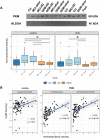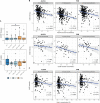This is a preprint.
Mass Spectrometry in Cerebrospinal Fluid Uncovers Association of Glycolysis Biomarkers with Alzheimer's Disease in a Large Clinical Sample
- PMID: 37461556
- PMCID: PMC10350182
- DOI: 10.21203/rs.3.rs-3073597/v1
Mass Spectrometry in Cerebrospinal Fluid Uncovers Association of Glycolysis Biomarkers with Alzheimer's Disease in a Large Clinical Sample
Update in
-
Mass spectrometry in cerebrospinal fluid uncovers association of glycolysis biomarkers with Alzheimer's disease in a large clinical sample.Sci Rep. 2023 Dec 16;13(1):22406. doi: 10.1038/s41598-023-49440-3. Sci Rep. 2023. PMID: 38104170 Free PMC article.
Abstract
Background: Alzheimer's disease (AD) is a complex heterogenous neurodegenerative disorder, characterized by multiple pathophysiologies, including disruptions in brain metabolism. Defining markers for patient stratification across these pathophysiologies is an important step towards personalized treatment of AD. Efficient brain glucose metabolism is essential to sustain neuronal activity, but hypometabolism is consistently observed in AD. The molecular changes underlying these observations remain unclear. Recent studies have indicated dysregulation of several glycolysis markers in AD cerebrospinal fluid and tissue.
Methods: In this study, unbiased mass spectrometry was used to perform a deep proteomic survey of cerebrospinal fluid (CSF) from a large-scale clinically complex cohort to uncover changes related to impaired glucose metabolism.
Results: Two glycolytic enzymes, Pyruvate kinase (PKM) and Aldolase A (ALDOA) were found to be specifically upregulated in AD CSF compared to other non-AD groups. Presence of full-length protein of these enzymes in CSF was confirmed through immunoblotting. Levels of tryptic peptides of these enzymes correlated significantly with CSF glucose and CSF lactate in matching CSF samples.
Conclusions: The results presented here indicate a general dysregulation of glucose metabolism in the brain in AD. We highlight two markers ALDOA and PKM that may act as potential functionally-relevant biomarkers of glucose metabolism dysregulation in AD.
Keywords: Alzheimer’s disease; Biomarkers; Cerebrospinal fluid; Glucose metabolism; Mass spectrometry.
Conflict of interest statement
Conflicts of interest S. Arnold has received honoraria and/or travel expenses for lectures from Abbvie, Eisai, and Biogen and has served on scientific advisory boards of Corte, has received consulting fees from Athira, Cassava, Cognito Therapeutics, EIP Pharma and Orthogonal Neuroscience, and has received research grant support from NIH, Alzheimer’s Association, Alzheimer’s Drug Discovery Foundation, Abbvie, Amylyx, EIP Pharma, Merck, Janssen/Johnson & Johnson, Novartis, and vTv. S.N. Leslie is a current employee of Janssen Pharmaceuticals. B. Carlyle has received grant funding from Ono Pharmaceutical. Other authors report no conflicts of interest.
Figures





References
-
- Chiti F, Dobson CM. Protein Misfolding, Amyloid Formation, and Human Disease: A Summary of Progress Over the Last Decade. https://doi-org.ezp-prod1.hul.harvard.edu/101146/annurev-biochem-061516-.... 2017;86:27–68. doi: 10.1146/ANNUREV-BIOCHEM-061516-045115 - DOI - PubMed
-
- Santos CY, Snyder PJ, Wu WC, Zhang M, Echeverria A, Alber J. Pathophysiologic relationship between Alzheimer’s disease, cerebrovascular disease, and cardiovascular risk: A review and synthesis. Alzheimer’s & Dementia: Diagnosis, Assessment & Disease Monitoring. 2017;7(1):69–87. doi: 10.1016/J.DADM.2017.01.005 - DOI - PMC - PubMed
Publication types
Grants and funding
LinkOut - more resources
Full Text Sources
Miscellaneous

